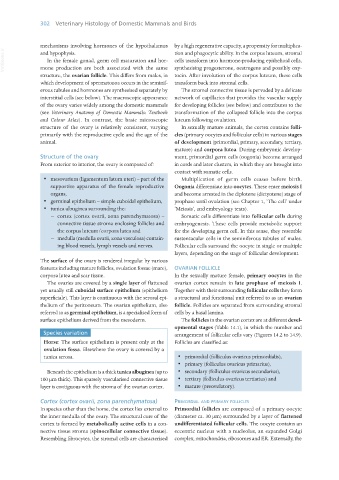Page 320 - Veterinary Histology of Domestic Mammals and Birds, 5th Edition
P. 320
302 Veterinary Histology of Domestic Mammals and Birds
mechanisms involving hormones of the hypothalamus by a high regenerative capacity, a propensity for multiplica-
VetBooks.ir and hypophysis. tion and phagocytic ability. In the corpus luteum, stromal
In the female gonad, germ cell maturation and hor-
cells transform into hormone-producing epithelioid cells,
mone production are both associated with the same synthesising progesterone, oestrogens and possibly oxy-
structure, the ovarian follicle. This differs from males, in tocin. After involution of the corpus luteum, these cells
which development of spermatozoa occurs in the seminif- transform back into stromal cells.
erous tubules and hormones are synthesised separately by The stromal connective tissue is pervaded by a delicate
interstitial cells (see below). The macroscopic appearance network of capillaries that provides the vascular supply
of the ovary varies widely among the domestic mammals for developing follicles (see below) and contributes to the
(see Veterinary Anatomy of Domestic Mammals: Textbook transformation of the collapsed follicle into the corpus
and Colour Atlas). In contrast, the basic microscopic luteum following ovulation.
structure of the ovary is relatively consistent, varying In sexually mature animals, the cortex contains folli-
primarily with the reproductive cycle and the age of the cles (primary oocytes and follicular cells) in various stages
animal. of development (primordial, primary, secondary, tertiary,
mature) and corpora lutea. During embryonic develop-
Structure of the ovary ment, primordial germ cells (oogonia) become arranged
From exterior to interior, the ovary is composed of: in cords and later clusters, in which they are brought into
contact with somatic cells.
· mesovarium (ligamentum latum uteri) – part of the Multiplication of germ cells ceases before birth.
supportive apparatus of the female reproductive Oogonia differentiate into oocytes. These enter meiosis I
organs, and become arrested in the diplotene (dictyotene) stage of
· germinal epithelium – simple cuboidal epithelium, prophase until ovulation (see Chapter 1, ‘The cell’ under
· tunica albuginea surrounding the: ‘Meiosis’, and embryology texts).
− cortex (cortex ovarii, zona parenchymatosa) – Somatic cells differentiate into follicular cells during
connective tissue stroma enclosing follicles and embryogenesis. These cells provide metabolic support
the corpus luteum/corpora lutea and for the developing germ cell. In this sense, they resemble
− medulla (medulla ovarii, zona vasculosa) contain- sustentacular cells in the seminiferous tubules of males.
ing blood vessels, lymph vessels and nerves. Follicular cells surround the oocyte in single or multiple
layers, depending on the stage of follicular development.
The surface of the ovary is rendered irregular by various
features including mature follicles, ovulation fossae (mare), OVARIAN FOLLICLE
corpora lutea and scar tissue. In the sexually mature female, primary oocytes in the
The ovaries are covered by a single layer of flattened ovarian cortex remain in late prophase of meiosis I.
yet usually still cuboidal surface epithelium (epithelium Together with their surrounding follicular cells they form
superficiale). This layer is continuous with the serosal epi- a structural and functional unit referred to as an ovarian
thelium of the peritoneum. The ovarian epithelium, also follicle. Follicles are separated from surrounding stromal
referred to as germinal epithelium, is a specialised form of cells by a basal lamina.
surface epithelium derived from the mesoderm. The follicles in the ovarian cortex are at different devel-
opmental stages (Table 14.1), in which the number and
Species variation arrangement of follicular cells vary (Figures 14.2 to 14.9).
Horse: The surface epithelium is present only at the Follicles are classified as:
ovulation fossa. Elsewhere the ovary is covered by a
tunica serosa. · primordial (folliculus ovaricus primordialis),
· primary (folliculus ovaricus primarius),
Beneath the epithelium is a thick tunica albuginea (up to · secondary (folliculus ovaricus secundarius),
100 μm thick). This sparsely vascularised connective tissue · tertiary (folliculus ovaricus tertiarius) and
layer is contiguous with the stroma of the ovarian cortex. · mature (preovulatory).
Cortex (cortex ovarii, zona parenchymatosa) PRimoRdial and PRimaRy follicles
In species other than the horse, the cortex lies external to Primordial follicles are composed of a primary oocyte
the inner medulla of the ovary. The structural core of the (diameter ca. 30 μm) surrounded by a layer of flattened
cortex is formed by metabolically active cells in a con- undifferentiated follicular cells. The oocyte contains an
nective tissue stroma (spinocellular connective tissue). eccentric nucleus with a nucleolus, an expanded Golgi
Resembling fibrocytes, the stromal cells are characterised complex, mitochondria, ribosomes and ER. Externally, the
Vet Histology.indb 302 16/07/2019 15:05

